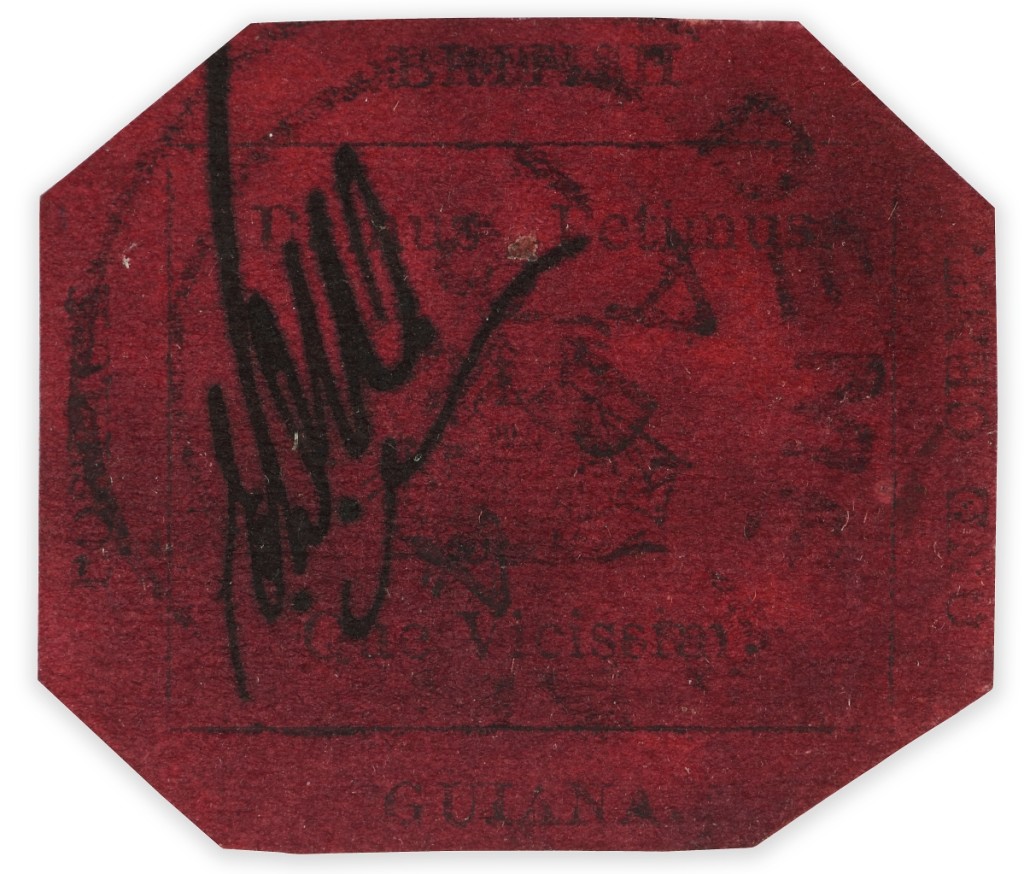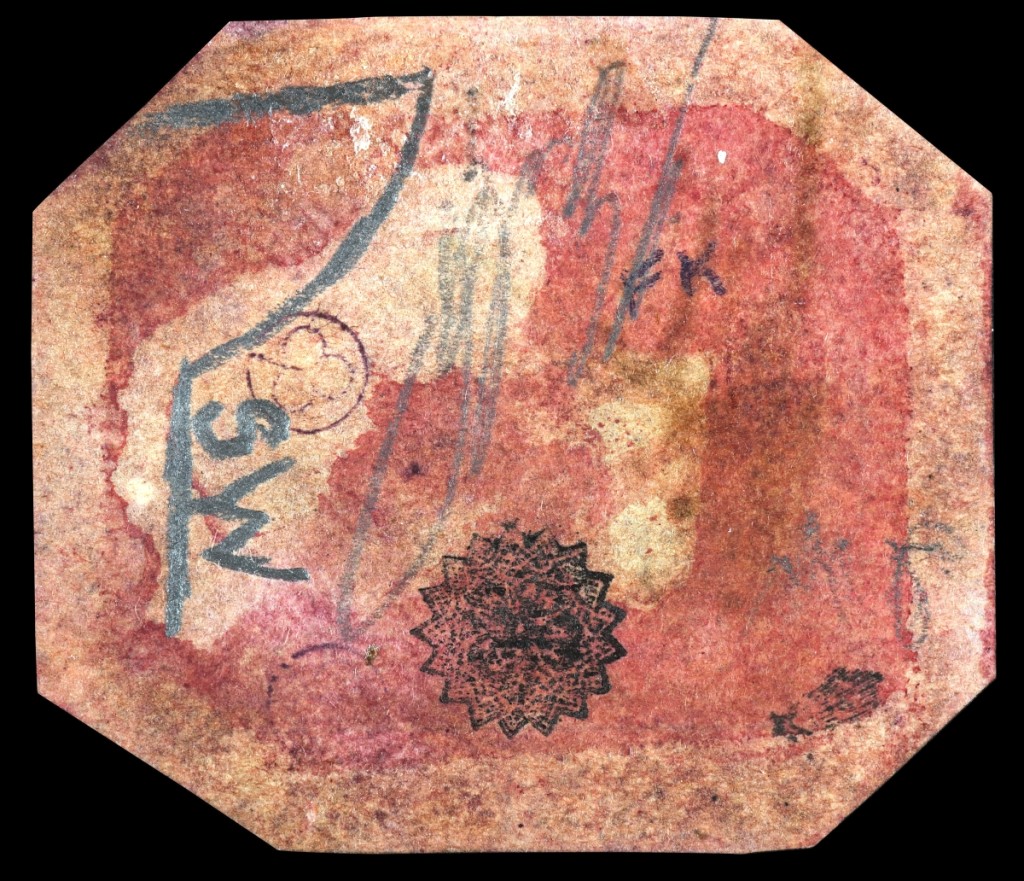When powerhouse stamp dealing firm Stanley Gibbons made an $8.3 million bid on the One Cent Black on Magenta stamp in 2021, they did so with a radical idea in mind. The most valuable stamp in the world, at various times sought by kings and owned by wealthy financiers, would be offered to the people through an emerging trend in the digital age: fractional ownership. Right now on Showpiece.com, anyone can purchase an ownership share in this famed stamp and become a part of its history. We sat down with Victoria Lajer, the managing director of philately for Stanley Gibbons, to get the scoop.
When did Stanley Gibbons decide to democratize ownership in the stamp?
It came in a funny sequent of events. We had looked at digital ownership separately a few months previous and then after that we suggested splitting ownership between a few different people. Then very quickly it turned to marrying the two ideas. In the end, it was only two or three weeks before the sale, it happened quite organically. And then we spent the rest of the time thinking about why we shouldn’t do it, and we couldn’t come up with anything. There were too many other good things about it.
Can you describe the first time you ever heard of the One Cent Black on Magenta?
No, not really. My father dealt in stamps so I probably heard about it at some point when I was young but I don’t recall an exact time. I joined Stanley Gibbons in 2014 right when the du Pont sale occurred. It’s a big stamp and we’re a stamp company, there was lots of chatter, I remember that day well. When it came up for sale again in 2021, I remember the night before the sale when we decided we were going to buy it. We did a call at 9 pm and I remember the feeling when we got off that group call, realizing we were going to take it and have a bid.
Has it always held its distinction in the philately world?
It’s unique. There are other unique items out there and they don’t have the same celebrity status, but it’s an issued stamp. As issued stamps come, it’s unique. And as the stories built around it, it gathered momentum through the decades. The back of the stamp is almost as famous as the front, it’s signed by most of the previous owners. You don’t get anyone signing stamps these days, it used to be a tradition of European dealers.
Tell me about its historic reputation from the time it was discovered.
The stamp began its new life as a collectible commodity in 1873 when a 12-year-old schoolboy, L. Vernon Vaughan, found it among family papers. It became part of his stamp collection, before he sold it to a local collector, Neil R. McKinnon, for the sum of six shillings. Vaughan was apparently convinced he’d find a better example of the stamp. A few years later, McKinnon sold his collection to a Liverpool stamp dealer, Thomas Ridpath, for £120. Ridpath then sold the One Cent Black on Magenta to the renowned collector and eccentric recluse Philipp von Ferrary. The sum paid was believed to be around £150. Ferrary, an Austrian who lived in Paris, died in 1917 and his collection was confiscated by the French Government, who claimed it as part of Germany’s war reparations. This was sold in a series of auctions between 1921 and 1925, with the One Cent Black on Magenta going under the hammer in 1922. It was bought by Arthur Hind, a British-born American millionaire, for a total sum of £7,343. Hind died in 1933. Following a legal battle over his estate, the stamp passed to his wife, who sold it for a sum believed to be around $45,000 in 1940. The buyer was Frederick Small and he allowed the stamp to be exhibited. One such occasion was at the Stanley Gibbons Catalogue Centenary Exhibition at the Royal Festival Hall, London, in 1965. It was next sold in 1970 in New York where an investment syndicate paid an estimated price of $280,000. One of its members was stamp dealer Irwin Weinberg. Some ten years later, it was sold again. This time, including commission, the massive sum paid totaled $935,000. The stamp’s newest owner was John E. du Pont, heir to the Du Pont Chemicals fortune and the subject of the 2014 film Foxcatcher. During its time in du Pont’s ownership, the stamp was rarely seen. That changed when du Pont died in prison and it next came up for sale. Before its auction in 2014, an extensive promotional ‘tour’ took place. In the age of celebrity culture, the stamp with rock star status traveled to see its fans! The tactics clearly worked. At auction, it sold for $9,480,000. Its newest owner was shoe designer Stuart Weitzman. Weitzman allowed the item to be widely exhibited, until it again returned to the auction room in 2021. It achieved a total price of $8,307,000 and the buyer was Stanley Gibbons Ltd, renewing their long-time relationship with the stamp after showing it 56 years earlier.

The famed One Cent Magenta, the most valuable stamp in the world, has been offered for fractional ownership by Stanley Gibbons on Showpiece.com.
How does the fractional ownership model work?
We have partnered with Showpiece.com to offer it. Stanley Gibbons is not a tech company, we’re a stamp company, so we decided that having a partner was the way to go. It’s become a slightly larger thing. We’ve got one item up there now but there are plans to offer others. The premise is the Magenta is split into a fixed number of 80,000 pieces. People are able to purchase these and the level of ownership is proportional to the amount of pieces owned. The great thing about it is we have the asset, it’s in our store, it’s on display, you can come and see it. Normally, it’s something that’s so expensive from a stamp-collecting perspective, only one person would normally own this stamp and only a few people with deep pockets could do that. But now that’s not true, anyone can. It’s all fun really, but you can digitally sign the back of it. Once you purchase your share, you get a picture of the back and you can place your initials on it. We’ve got a big image of it on our wall in our shop, too, and people can sign the back of it there. But we are adamant we don’t want to physically sign it, it’s just to provide a bit of interaction.
Cost per share?
£100. It was important to us that we made it accessible to most people.
Do you expect that price to stay static or will it fluctuate?
When you purchase from us, it will be £100. With the piece you get a number of benefits and if you purchase more pieces, you get a few more.
Can owners sell their shares?
Yes, once the marketplace opens on Showpiece.com, owners will be able to sell their pieces, it will be up to the market to determine the price of them at that point.

To its back are some of the signatures of the One Cent Magenta’s
past owners, a tradition that goes back to European philately dealers.
In what situations would the fractional share term end?
If a buyout offer was received for the Magenta, a vote would occur where owners get one vote for every piece they hold. It would take 60 percent of voters in agreement to create a sale. If they vote to sell, the net proceeds after fees and costs would be distributed to owners based on the number of pieces they held.
The fractional ownership is part of the history of it, we expect it to go back to the market. It might be ten or 20 years, I’m not sure, but I think it needs to be out there. Dealers don’t like collectors giving their collections to institutions because you can never trade that stamp again. That to me doesn’t feel like the spirit of collecting and sharing. We’re doing that by having more people collect and own it. It keeps the story going.
It lost a little value between its last two auction sales, what makes you confident the value will rise again?
History would suggest that it would increase. Stamp collecting is not a fast-paced market, so the time between the two prior sales, 2014 to 2021, is very short in stamp years. That first sale feels like it was yesterday. I wasn’t hugely surprised and Stanley Gibbons was pleased at the price we got it for, we didn’t reach our max bid on it.
If the pieces sell out, Stanley Gibbons will have raised more than $5 million. Do you liken it to crowdsourcing?
No, we’re not raising the funds, I wouldn’t liken it to crowdsourcing, that’s not the point of it. If we get to the target, we get there. If we don’t, we don’t. It might be a slightly expensive way to do it, but one of the points for us is to expose the hobby to as many people as possible. More people need to be involved in stamps, and they should be, it’s super interesting and it’s a hobby for everyone. You need something like this to do that. If the Magenta can open up the hobby for other people, I feel like that’s a great success. It’s fun to be part of something that’s innovative, there aren’t any other companies in stamps that put so much money into the hobby as Stanley Gibbons, and I feel very proud of that.
What kinds of people are you hearing from? Are they all stamp collectors?
It’s a real mix. We did a long run up to gauge interest, and when we checked our own database against the fractional owners to see how much matching there was, I was blown away. I thought the crossover would be really high but it wasn’t. It’s nice to see. It shows that it has opened up stamps to a wider audience. Certainly, many collectors have bought it, but it’s a nice mix of people.
Tell me about some of the other major purchases made by Stanley Gibbons in company history. Was the Magenta the highest bid the company has ever made?
We’ve been around since 1856, which is incidentally when the Magenta was printed, so as a company we have made countless purchases of rare philatelic items over the decades. If we haven’t bought or sold it, we’ve auctioned it. There is a huge gap between the Magenta and the rest of stamps though. We’ve handled the famous Great Britain Penny Red plate 77 in recent times, which at the time was priced at £475,000.
It’s the only major postage stamped ever issued by the British Empire not represented in the Royal Philatelic Collection. Ninety-nine years ago, King George V tried to buy it. Do you feel there’s something poetic about offering it to the masses instead?
We did bear in mind that the Royal Collection was missing the stamp. It is believed that at some point King George V (Prince of Wales at the time) was offered it and actually did say no to it, though he did subsequently try to buy it at auction.
-Greg Smith





